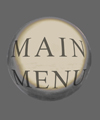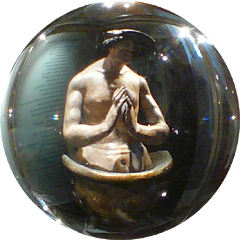
In the art and mathematics of Piero della Francesca, the 13,14,15 triangle that defines the prism on the Reloading Humanism Main Menu, is a long sought missing link with hidden properties. That this was known and appreciated outside Italy is shown by a sculpture of Saint Vitus held by Museum Krems. At Reloading Humanism, this statue serves as a male counterpart to the Venus of Willendorf and so is likewise an emblem of the site and its mission. The story of the triangle and the Saint can either be read as an article published by the Krems Town Archive (soon to be up-loaded) or in summary form by clicking on the toggle title below. For those who, in addition to the full story, want to know more about the role of geometry in the paintings of Piero della Francesca, there is the Reloading Humanism Guide, Art and Mathematics in Krems, the Wachau and Borgo Sansepoolcro, which along with online ordering options is previewed on the Reloading Humanism Books & Music page.

As the title implies, other aspects of mathematics, such as astronomy, the calendar and the nature of irrational and transcendental numbers also feature, along with an introduction to Plato, Renaissance Neo-Platonism and questions of theology.
The Triangle and the Saint
The story of the triangle and the saint begins in the Antique, with the triangle being discovered by Hero of Alexandria (10-85 AD). The 13,14,15 triangle is the tenth example of a series of triangles whose sides are all a whole number of units in length and whose area is also given by a whole number. Named after Hero, such of triangles are called „Heronian Triangles“.
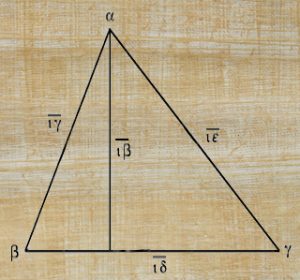
In his Metrica, Hero surveys the ways by which the areas of plane figures may be ascertained and in Book I, Proposition 5, considers a 13,14,15 triangle. Constructing a line that is perpendicular to the side of 14 units and which intersects with the point a, on the opposite corner, he shows that such a line has a length of 12 units. From this he then goes on to show that the triangle has an area of 84 units.
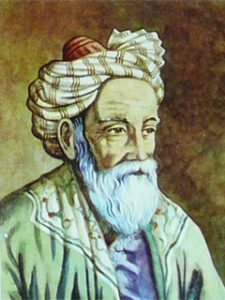
When the Greek mathematical tradition came to an end, Hero’s Metrica was lost and for centuries, the triangle was unknown in the West. Yet it was preserved in the Arabic tradition and was discussed by authors such as Thabit ibn Qurrah al-Harrani in his tahrir kitab al mafrudat or Book of Assumptions. See archive.org for the kitab al-mutawassitat, owned by Columbia University in which Thabit’s tract is to be found on pages 256-253 (ff. 112r-115v).
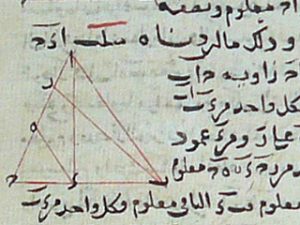
During the thirteenth century, the triangle was brought back to Europe by Leonardo of Pisa (circa 1170-1240), otherwise known as Fibonacci.
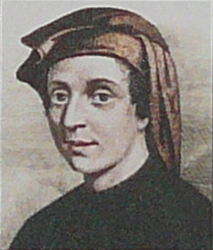
In De practica geometrie Fibonacci discussed the 13,14,15 triangle ten times, while after him, in his Trattato d’Abaco, the artist and mathematician Piero della Francesca (1412-1492), devoted 18 exercises to it. In his later Libellus de quinque corporibus regularibus, Piero della Francesca reused 13 of the exercises from the Trattato d’Abaco and introduced seven new ones.
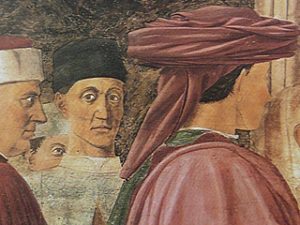
In his epic cycle, The Legend the True Cross, painted in fresco in the Apsis of the Cathedral at Arezzo, in the The Meeting of Solomon and Sheba, following the convention of the time, Piero della Francesca shows himself loolking ot at the viewer. Following in Piero’s footsteps was his townsman and fellow mathematician, Luca Pacioli (circa 1456-1517). Pacioli’s De summa arithmetica, geometrica, proportioni e proportionalita of 1494, begins with a thumb-nail image of Pacioli teaching geometry and in the work, the triangle is the subject matter of 37 exercises.
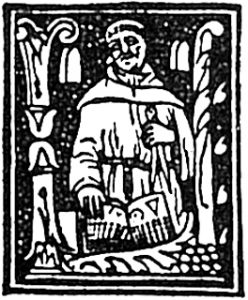
Among the exercises on the 13,14,15 triangle given by Pacioli, two are concerned with columns which, like the prism on the Reloading Humanism Main Menu, have the triangle as a cross-section. Significantly however, in both of these exercises, as well as in all the other examples referred to above, the circle is missing.
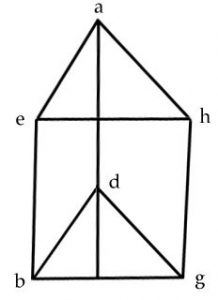
Books at that time were sold unbound so that owners could have them bound as they wished. At some unknown point in time, the loose leaves of Piero’s Libellus were bundled together with those of pacioli’s second book, Divinia Proportione. That this was not originally intended is shown by the fact that in all the copies of Divinia Proportione that have survived, the ordering of the different parts is inconsistent, illogical and careless. Providing a prime example of this is the copy of Divinia Proportione held by the National Library in Vienna: digital.onb.ac.at.
Bound in as a part of Pacioli’s Divinia Proportione, Piero’s Libellus made its way to Krems. There an oblique hint given by Piero at the end of his book, was taken up and used in the composition of a sculpture commissioned by the burgesses of the town. This was the Museum Krems sculpture of Saint Vitus in a Vat, which was made for the Burgesses‘ Hospice in Krems This was where the sick and infirm were cared for. As he was said to have cured the son of the Roman Emperor, Diocletian of epilepsy, Saint Vitus was invoked in cases of epilepsy and is the patron saint of apothecaries. In addition, he was invoked in cases of dancing mania and is the patron of dancers and musicians.
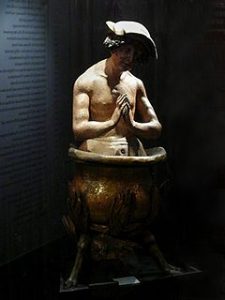
As is customary for depictions of Saint Vitus, the Museum Krems sculpture shows shows Saint Vitus kneeling in a vat of boiling oil, this being the manner in which he was martyred. Carved from wood by an anonymous artist, the sculpture dates from around 1520. At the front, the cauldron is supported by two legs with lion’s feet, whilst at the back it is supported by a column. The column is however a latter addition and was added so as to replace a third leg, which was brutally broken off. The missing leg and the attention given to the muscles of the Saint’s back suggest that the work was originally intended to be seen at eye level in a position that allowed it to be seen from all sides.
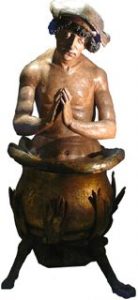
Highly significant is the fact that the two front legs are markedly asymmetrical. If the outermost points of the legs are connected and joined to the point where the third leg will have touched the ground, the result is a 13,14,15 triangle. This and other features, suggest that the 13,14,15 triangle was a deliberate and integral part of the composition. The purpose of this was so that a sacred space could be brought into being in which the laws of space and time were being suspended.
During the Second World War the Krems statue, Saint Vitus in a Vat, was one of thousands of works of art that, despite being stored in a salt-mine, was very nearly blow up and then came worryingly close to being taken as a trophy to Russia. The full story is told in the Reloading Humanism Guide: Undercover, Under Wraps, Underground: Masterpieces from Brugges, Krems and Wienerneustadt in Altaussee, which along with on-line ordering options is previewed via the Books & Music page. Alternatively, click on the toggle title below for a summary.

The Saint's war-time Odyssey
In 1943, as the tide of war began to turn against Nazi Germany and Allied bombers were able to reach Krems, the sculpture was moved to Schloß Baumgarten. This is a Baroque pocket palace built on the slopes overlooking Mautern. Along with Saint Vitus in a Vat there were 3 other sculptures and 13 large boxes containing diverse items, all from the municipal museum. From the town’s archives there were 18 boxes of documents, 2 boxes of engravings and 12 boxes of books and codices from the nearby abbey of Göttweig.
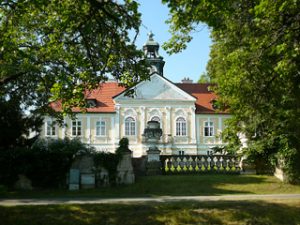
During the summer of 1943, the director of the Institüt für Denkmal Pflege (IDP), or Institute for the Conservation of Monuments, Dr. Herbert Seibel had been scouting the Austrian countryside for places where art could be safely stored. Investigating the salt mines of Salzkammergut, he found that a mine at Altaussee was not only extensive but also offered perfect storage conditions. Accordingly, he arranged for important works of art from small museums, churches and monasteries in Austria to be stored in the mine. The first of these items were the sculptures by Lorenz Luchsperger from the cathedral at Wienerneustadt. These arrived in Altaussee on the 25th and 26th August with a second delivery of items following in the middle of October.

On 28th October 1943, the director of Krems Museum, Hans Plöckinger, entrusted the IDP with two boxes of manuscripts from Göttweig Abbey (Ma I, Ma II), five boxes of mixed items from Krems Museum (Mu 4, 8, 9, 10, 11) and three „gothic“ statues all of which had been in storage at Schloß Baumgarten. The three sculptures were Saint Vitus in a Vat, Saint John the Evangelist and Saint Margret and the Dragon, with the latter two both having „KREMS“ daubed in rough and ready black letters on the back.
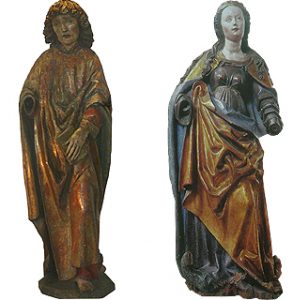
This third delivery arrived in Altaussee at the beginning of November and was followed by a forth and final delivery in January, 1944. At the beginning of November, the arrival of the Krems pieces from Schloß Baumgarten was recorded and the list drawn up, when compared with the list of items that remained in Schloß Baumgarten, shows that the box numbers missing on the palace list, are the boxes that had been sent to Altaussee. Thus here again, Saint Vitus‘ presence in Mautern can only be inferred indirectly from the Altaussee list of items that had arrived from Schloß Baumgarten. Assigned Altaussee inventory numbers, the three sculptures from Krems (66, 67, 68), along with the boxes from Göttweig (79, 80) and Krems (76, 77, 78, 81, 82) were deposited in a specially adapted chamber known as the Springerwerk. A plan drawn up on 5th November 1943 shows the locations of the boxes and of Saint Vitus in a Vat (66).
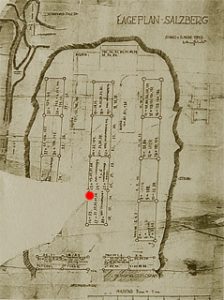
On the plan, the entrance to the chamber is at the bottom, with the boxes from Krems and Göttweig being located at the opposite end and with the Saint John the Evangalist and Saint Margret and the Dragon being presumably stored in the area that on the plan that is missing as their inventory numbers (68 and 67) are missing. On the otherside of the storage shelf on which the sculpture of Saint Vitus was placed, there were life-size wooden sculptures of apostles and angles made by Lorenz Luchsperger for the cathedral at Wienerneustadt.
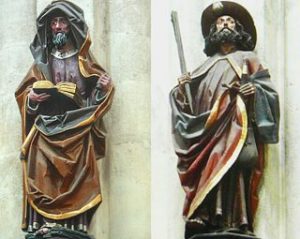
From the plan and from a photograph taken by the IDP, a view of the Springerwerk can be reconstructed with the Krems and Göttweig boxes being at the end and the Luchsberger sculptures on the bottom shelf with sheets of cardboard laid on top so as to protect them from dust. On the drawing, the position of Saint Vitus in a Vat is on the otherside of the first bay on the left.
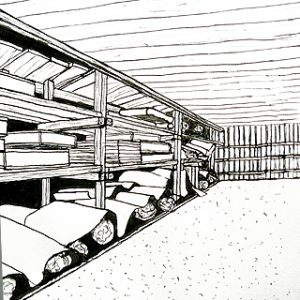
When word of the mine’s suitability as a place of storage reached the management of the Führersammlung, the growing collection of art that Hitler was determined would one day outstrip the Louvre and the Ufficci, the remaining space was reserved for the new museum, with the IPD managing the collection under contract and passing the costs on to the Führersammlung. Other museums in Austria, such as the Kunsthisorisches Museum in Vienna and the National Library, therefore deposited their works in a salt mine at Lauffen not far away. Logistically, Lauffen was easier to get to and works intended for Altaussee were transported first by train to Bad Aussee and from there by lorry over the Pötschen Pass into the Altaussee basin and then up to the mine. In winter, for this last leg of the journey, instead of lorries, once British POW’s hd cleared away snow, a caterpillar-tracked transporter designed for the eastern front was used to carry works the up through the woods. Later on, when fuel became scarce, carts pulled by oxen were used. Today the caterpillar-tracked transporter used at Altausee can be seen at the Museum of Military History in Vienna (Heeresgeschichtliches Museum).
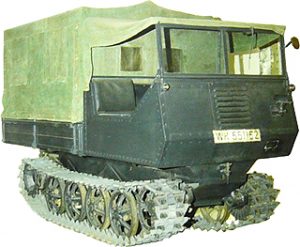
Along with the incoming art works, there were also teams of art historians and restorers who, working in specially adapted galleries, documented the incoming works and restored the damage inflicted by transport. Among the experts draughted in, was Hermann Michael, a mineralogist from the Museum of Natural History in Vienna who was reponsible for the practical aspects of storage. Another expert was the chemist Maximillian Eder who during the summer of 1944 wrote, The Deposition Ballard, in which the humerous aspects of daily life in the mine are recorded in rhyming couplets.
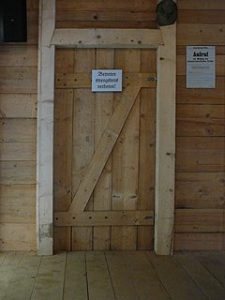
From the autumn of 1943, right up into the last months of the war, the steady stream of art works arriving for the Führersammlung never stopped. Among the late arrivals were Hubert and Jan van Eyck‘ The Adoration of the Lamb and Michaelangelo’s Bruges Madonna. Although the van Eyck altarpiece had been smuggled to Vichy France, it was handed over to Germany on special orders. Stored in Schloss Neuschwanstein, the work was only moved to Altaussee when allied bombers were able to reach into the heart of Bavaria.
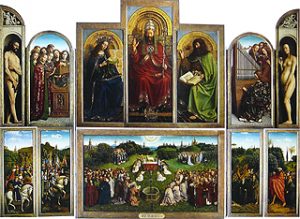
Likewise coming from Belgium, was Michaelangelo’s Bruges Madonna which had taken from the Church of our Lady and loaded onto onto a Red Cross truck at the beginning of September 1944. As the land route out of the city was blocked by the advancing Allies, the masterpiece languished in a dock before leaving the country by ship, arriving in Altausee on 6th October to join the van Eyck altarpiece which had arrived only shortly before.
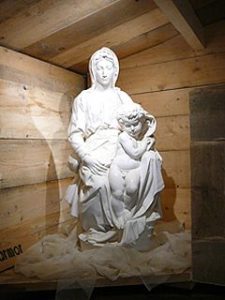
In his memoirs, Emmerich Pöchmüller, the director of the mines and salt-works in Altausseer Land, wrote: „Inextinguishable were the impressions gathered whilst doing my rounds through the tunnels and galleries of the mine. One opened a door and suddenly stood one stood face to face … with an image that one had known since childhood but always separated by a distance in the impersonal context of a museum. Instead of being at arm’s reach, the pieces of the Gent Altarpiece were there to be held and looked at individually and wherever one went there were beautiful things, candelabra’s, jugs, and fine furniture, with magnificent sculptures looking down from the shelves. It was a unique, magnificent atmosphere and whoever saw the mountain’s treasures was moved and captivated by the spell“.
With a stable temperature of around 8°C and a humidity of 75% that hardly varies, the mine offers perfect conditions for the storage of artefacts made of organic materials and it was thought, would be safe from bombs. Yet a few months later, the serene security of this subterreanian world suddenly began to dissolve.
19th March, 1945: Hitler issues the „Nero Decree“ which states that, „all military transport and communication facilities, industrial establishments and supply depots, as well as anything else of value within Reich territory, which could in any way be used by the enemy immediately or within the foreseeable future for the prosecution of the war, will be destroyed“
30th March, 1945: the last train load of art for the Führersammlung is evacuated from Vienna and 36 hours later arrives at Bad Aussee where the contents are loaded onto lorries for the journey to Altaussee
10th April, 1945: in accordance with orders given by the Gauleiter or governor of the region, August Eigruber, four crates are delivered and deposited deep inside the mine.
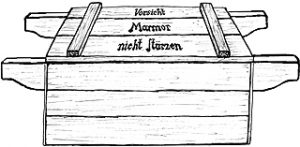
Stamped with the warning „Careful, marble, do not drop„, the delivery and its deposition is overseen by Eigruber’s number two, Johann Glinz and everything about the delivery is unusual
13th April, 1945: on the day the Red Army enters Vienna, Glinz and a second delivery of crates arrives at the mine and the crates are likewise transported deep inside. Meanwhile at Bad Ischl where Pöchmüller has his office, Hellmuth von Hummel arrives. Von Hummel is the personal assistant of Hilter’s general secretary, Martin Bormann. To the assembled managerment of the saltworks and the collections stored at Altaussee, von Hummel announces that the crates contain bombs and that following the Nero Decree to the letter, Eigruber’s instructions are for the mine and everything in it to be destroyed. The secret of the crates aired, heated discussions break out among the management about what is to be done and how in this case, the Nero Decree is to be intpretated. Aware that the war will soon be over, von Hummel does not committ himself to explicitly endorsing any particular course of action other than that some form of detonation should take place. At Pöchmüller’s insistance, he calls Berlin and receives confirmation that the art works stored in the mine are not to be destroyed. Pöchmüller and Michael agree that destroying the entrances is a viable way of preventing complete destruction, with Michael advising Pöchmüller to downplay the technical difficulties involved. Von Hummel then leaves as he has money and gold that is to be hidden in the region
14th April, 1945: Pöchmüller tries to contact Eigruber
16th April, 1945: Pöchmuller travels to Linz and failing to get an appointment with Eigruber leaves a message. Pöchmuller is informed by telephone that plans for the mine’s destruction are unchanged. Pöchmüller and Michael along with Mayerhoffer, who like Pöchmüller is a part of the management of the salt works, discuss the pratical details of how Eigruber’s plan can be subverted and complete destruction prevented
17th April, 1945: Travelling again to Linz and this time getting through to Eigruber, Pöchmüller requests permission to destroy the entrance to the mine first so that when the main charges go off, destruction will be more effective. Eigruber dismissively tells Pöchmüller to do what he thinks best – just as long as the mine and its contents are destroyed
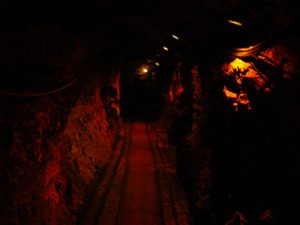
18th April, 1945: not in senior management and not at the meeting in Bad Ischl, Altaussee mine manager Otto Höger, is instructed by Pöchmüller to draw up plans for a detonation of the mine entrances at six different places that will seal the mine. Far from simple, this involves a condiderable amount of technical planning and calculation
19th April, 1945: Head of Security, Ernst Kaltenbrunner, is in Berlin for the last time with the intention of convincing Hitler to make peace with the Americans. Like Hitler, Kaltenbrunner is from Linz and instead of addressing matters at hand, the Führer leads Kaltenbrunner into a small room and shows him a model of the new Linz that is being planned, together with the new museum. He then says: „My Dear Kaltenbrunner, if the two of us were not convinced that after the final victory, we would together rebuild Linz, then I would shoot myself today“. As attempts at serious conversation are futile, Kaltenbrunner takes leave of the Führer and visiting Himmler, is entrusted with power over Ausria and Bavaria should communications within the Reich breakdown
20th April, 1945: Höger is informed of Eigruber’s orders to completely destroy the mine and its contents is told of the real nature of Pöchmüller’s plan to seal the entrances and agrees to co-operate
22nd April, 1945: a telegram is sent from Berlin in which it is expressly stated that only the entrance to the mine is to be destroyed not the mine and its contents
23rd April, 1945: armed with pistols, Seibel and Siebler begin to remove the important works from the Führersammlung, such as Vermeer’s The Painter in his Studio, to places deeper within the mine. Important Austrian works entrusted to the IPD at Seibel’s initiative are moved to locations outside the mine, such as the local church and vicarage. Unaware of the measures to save the mine being taken at management level, among the miners rumors are rife and although it is agreed that action must be taken, no consenus is reached. This is partly because the once tightly-knit band is divided by differences of opinion, with some miners being active Nazis, such as mine officer, Anton Kain, who is head of the Altaussee NSPD and a friend of Eigruber’s, whilst others have contact with the resistance
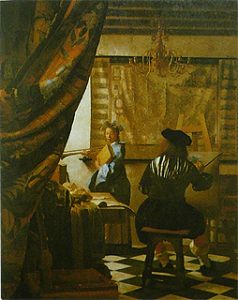
24th April, 1945: Eder also becomes involved helping move important works to safer places. To maintain secrecy, Seibel rejects the idea of involving the mine workforce
26th April, 1945: to speed up the practical implementation of the detonation of the mine entrances, the miners work in double shifts with some 500 holes being bored over the course of 140 working hours
27th April, 1945: telephone lines to Berlin are no longer working. Seibel makes hasty arrangements for 92 items entrusted to the IDP to be moved to the mine at Lauffen and at 3.00 p.m. two lorries leave Altaussee. Among the items is the St. Florian Altapiece by Albrecht Altdorfer and some of the Luchsperger sculptures from Wienerneustadt.
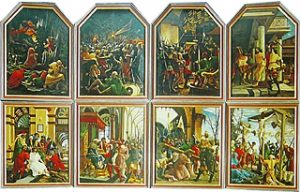
Due to a misunderstanding, the first lorry drives through Lauffen and only stops at Bad Ischl some four Kilometres further on. To prevent separation, the second lorry and follows and as the day is drawing to a close, it is decided to leave the delivery at a tavern in the care of an employee of the Natural History Museum in Vienna. This is the Gasthof Engljähringer, in the Grazer Straße 39 and the items are piled up on the veranda
Around this time, the three sculptures from Krems Museum are sent to the Parish Church at Bad Aussee and presumably in the same consignment, the remaining Luchsperger sculptures from Wienerneustadt, these latter being deposited in the Hospice Church in Bad Aussee. While the inventories testifying to these depositions only begin in January 1946, the nature of later events mean that the transfers to Bad Aussee must have taken place at some time before 5th May, 1945
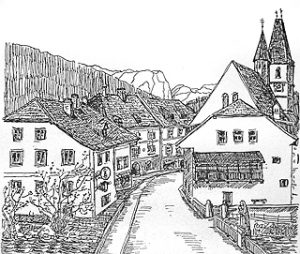
A drawing by local artist Irmgard Schlömmer, showing the Marktplatz at Bad Aussee. On the right there is the Hospice Church and behind it, the tower of the Parish Church
28th April, 1945: for the 92 items at Bad Ischl, neither vehicles nor staff are available and the consignment remains at the tavern. In Bad Ischl Pöchmüller and Michael receive a representative of the NSPD from Vienna, who brings in writing the telegramm from 22nd April. Pöchmüller issues Höger with written instructions to remove the bombs
29th April, 1945: Hitler dictates his will wherein it is stated that: „the paintings acquired over the years were never bought for my private consumption but were always collected so as to enlarge a gallery in my hometown of Linz on the Danube. That this be realised is my deepest wish“
30th April, 1945: Hitler shoots himself and his mistress. Either tipped off by an informat or as result of tapping the mine’s telephones, Glinz has suspicions that sabotage plans may be afoot. Appearing in Högler’s office, he threatens the mine director with a pistol, telling him that the detonation team is already on its way from Innsbruck and will arrive in two days‘ time. He then informs Pöchmüller that Eigruber refuses to accept the authority of the telegram as it was only signed by Bormann and not by Hitler himself. Glinz then has four of the bombs moved to a place in the mine which can be reached from a lower level. This means even if the mine were to be sealed the four bombs could still be accessed from below. On his way back to Linz however, Glinz is involved in a car crash. Taken to hospital in Gmunden, he is incapcitated and plays no further role
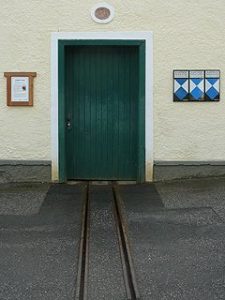
1st May, 1945: Högler finds the mine guarded by solders who control everyone who enters and leaves the mine
2nd May, 1945: two miners enter the mine at night and establish that the eight mysterious boxes do indeed contain bombs. These were dropped over Linz by American bombers and failed to detonate. Each bomb weighs 1,100 lbs/500 Kg
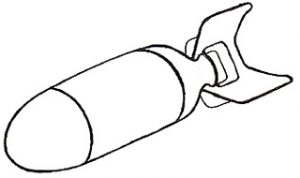
3rd May, 1945: Högler is informed of the whereabouts of the bombs and told that according to information supplied by the resistance, the arrival of the detonation team is immeninent. With Pöchmüller absent in Bad Ischl, Höger, Michael and others consider moving the bombs so that the sabotgae plan can, if necessary be effectively executed. Michael advises that the situation be explained to the miners and a course of action agreed upon
At midday it is decided that the bombs are to be guarded by the miners and the detonation team prevented from performing its task. In addition, it is agreed that support should be obtained from Kaltenbrunner who is in Altaussee with his mistress, the Countess of Westarp, who has recently borne him twins
Arriving in Altaussee late in the afternoon, Kaltenbrunner is asked by a miner who knows him for help and at 18.00 p.m. Höger is ushered in and told by Kaltenbrunner that the bombs are to be removed and that the detonation team will be stopped
At 20.00 p.m., on Höger’s orders, a team of miners is allowed by the war-tired and unfed guards to enter the mine
Alerted by an informant, at 11.30 p.m. Eigruber sends two soldiers to the mine and two to arrest Kaltenbrunner. Whether those sent to the mine, perform their duty and encounter the armed resistence of miners is unknown. At the Villa Rosa, those sent to arrest Kaltenbrunner are seen off when the head of the state security appears with his overpowering presence and SS guards
Around 00.30 a.m. there is a heated telephone conversation between Eigruber and Kaltenbrunner which is overheard by the switchboard operator. At 00.50 a.m. the bombs are outside the mine but are not otherwise disposed of
4th May, 1945: by the early morning the bombs have been hidden in the woods at the foot of the mountain and the same day work begins on the final preparations for the detonation of the entranceways. This takes 20 hours
5th May, 1945: early in the morning Kain, who may have overheard Högler giving the orders for the bombs to be removed and given Glitz the tip, is arrested by members of the resistence. Later during the day, the entrances to the mines at Altaussee and Lauffen are detonated
7th May, 1945: the American Third Army reaches the Pötschen Pass that leads into the Altaussee basin. Accompagnied by local guides, Kaltenbrunner trecks up into the mountains of Totengebirge in order to make himself scare for a while. The service rendered by the guides may be a repayment for his having helped save the mine. Kaltenbrunner’s plan is to later offer his services to the Americans in the coming war against Bolshavism
8th May, 1945: the Americans arrive in Altaussee at around 15.00 p.m. and at around 17.45, commanded by Major Ralph Pearson, two jeeps and a truck of soldiers approach the mine. With Pöchmüller in Bad Ischl, Michael is the only person who speaks English and claims sole credit for having saved the mine and its contents. Although Michael is an NSDP member, he claims his joining the party was a matter of duress and to substantiate his claim he is also member of the resistance group „Salzberg“ and has a card that has been backdated to 1944. Taking this at face value, Pearson places Michael in charge of the art and artefacts in the mine. As an NSDP member and with no one to speak up for him, Höger is denounced and arrested
9th May, 1945: Germany surrenders unconditionally, with it already being agreed by the Allies and Russia that Germany and Austria are to be made into occupied territories that are to be divided between England, France, the United States and the Soviet Union, with the four nations independently administering the areas allocated to them. Informing Seibel and Sieber that he is now in charge, Michael orders the two to return the works of art secluded two weeks before in various locations. With the exception of the consignments at Bad Ischl and Bad Aussee, this is carried out. Michael also demands from Seibel the inventories of the mine’s contents. Although incomplete, these list thousands of works, including the works entrusted to the IDP by Krems Museum and are the only available record of what is in the mine
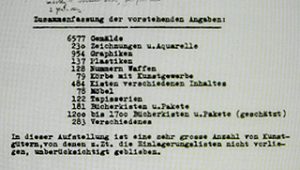
Over the course of the next few days, Pöchmüller repeately tries, unsuccessfully, to get from Bad Ischl to Altaussee to make contact with the Americans
12th May, 1945: Kaltenbrunner is betrayed and arrested in a mountain cabin. Around this time, the once enthusiastic Nazi, Seibel, is denounced and loses his job. Meanwhile, prompted by some form of tip-off or information, in Bad Ischl, NSDP member Pöchmüller is abducted by members of the Salzberg resistance group and delivered to the Americans. In the process he is so roughed up that he loses six teeth and for a whole day is unable to stand. Of those knowledgable of both the mine and its contents, this leaves only Michael, Sieber and Eder, with Michael having everything to gain from both denouncments. Summarising what has been going on, around this time a staged photograph is taken which makes headlines in the American press. This shows Michael at the centre of a group of miners, with GI’s to his immediate right and left and with a clearly disgruntled Sieber also in the first row
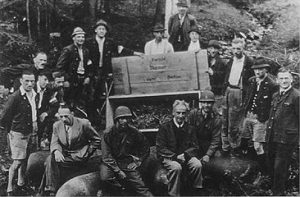
13th May, 1945: the consignment at Bad Ischl is reported to the Americans and it is emphasised that, consisting of Austrian artefacts it ought to remain in Austria
16th May, 1945: Captain Robert Posey and Pcf. Lincoln Kirstein of the Monuments, Fine Art and Archives division (MFAA) arrive in Altaussee and initiate the clearing of the tunnels which they are told, will take two weeks
17th May, 1945: Posey and Kirstein crawl through a hole in the rubble and find a panel of the Ghent altarpiece and the Bruges Madonna
21st May, 1945: MFAA man, George Stout, arrives in Altaussee and from the catalogues sees that there are 6,577 paintings, 230 drawings, 954 graphic works, 137 sculptures, 128 pieces of arms and armour, 79 baskets of objects, 484 cases of objects thought to be archives, 78 pieces of furniture, 122 tapestries, an exact count of 181 boxes of books and posters, along with a further 1,200-1,700 boxes of the same and 283 diverse items. In addition there is a „very large number“ of uninventorised works. Stout confirms that the mine offers perfect storage conditions and that from a conservation point of view, there is no danger of damage. His job is to arrange and oversee the packaging and transportation of the collection to a central depot in Munich. For this Stout estimates that he will need a year. The Central Collecting Point (CCP) is housed in the „Führerhaus“ where Hitler lived when in Munich and the former NSPD buildings immediately nextdoor, with the two being linked by underground passages. Stout also conducts interviews with people involved with the mine, its contents and the events of its being saved and finds that discrepencies are rampant and points of consensus few and far between. In his diary he writes: „I am sick of all schemers, of all the vain crawling toads who now try to edge into positions of advantage and look for selfish gain or selfish glory from all this suffering“
5th June, 1945: prior to the dividing up of Austria and Germany into administrative zones, a line decided by the European Advisory Council months before in London, is to serve as a division between Allied and Russian forces. As the Allied forces are significantly East of the line, Stalin refuses to agree to a summit meeting or to any convention until this agreement is honoured. With Eisenhower’s approval, Truman orders that in Germany, the withdrawal is to begin on 21st June. Concerning Austria, he says that arrangements should be „left to local commanders“. This so-called „Presidential Directive“ means that although the mine at Altaussee has been saved from destruction, there is a very real danger of its contents falling into Soviet hands and being sent to Russia. As this danger is appreciated, it is argued that the American Army is in a trustee position and in the future will be held accountable for the fate of works of art currently in its possession and that looted and displaced cultural artefacts not belonging in Austria and Germany cannot simply be abandoned
15th June, 1945: the detonated tunnels of the mine are clear of rubble
16th June, 1945: the first convey of 8 trucks leaves Altaussee and arrives in Munich the next day
18th June, 1945: instructions are issued that displaced art and artefacts currently in American custody are to be moved back to the American Zone along with army material. As Stalin is occupied with Eastern Germany the date by which the Decree is to take effect is postponed to 1st July. Unaware of these looming and impossible deadlines, Stout records that only two truck loads have been loaded and that he is short of men
24th June, 1945: news of the Presidental Decree reaches Altausse and a race against time begins with Stout recording that the working day has been extended from 4 a.m. to 20 p.m. Logistics are difficult and communication is unreliable. There is a lack of trucks and those that are available break down. Packaging materials, food and billets are scarce and it rains. „All hands grumbling“
1st July, 1945: with no news on the administrative boundaries in Austria, Stout and his team continue working frantically
9th July, 1945: the administrative zones are agreed upon, with Altaussee falling under American administration so that there is no more danger of the art works falling into Soviet hands
10th July, 1945: Michangelo’s Bruges Madonna and Jan van Eyck’s The Adoration of the Lamb are loaded onto a truck and transported to Munich
13th July, 1945: the consignment at Bad Ischl is loaded onto four trucks and taken to Munich which arrive that evening. Apart from the Altdorfer altapiece and some of the Luchsperger sculptures, there are the two boxes of manuscripts from Göttweig as well as boxes and cassettes containing thousands of coins and medallions. The two boxes fron Göttweig receive the Munich Inventory Numbers, 4245, 4247 with further two digit numerals being appended thereafter to identify individual items. See dhm.de/datenbank/ccp and dhm.de/datenbank/ccp for the CCP „Property Cards“ assigned to each Göttweig item
19th July, 1945: at Altaussee Stout reports that in just under a month, 80 truckloads of 1,850 paintings, 1,441 cases of paintings and sculpture, 30 pieces of furniture and 34 large packages of textiles have been extracted and transferred to Munich
6th August, 1945: after over a year in Europe during which time he only took a day and a half off, Stout returns home on a steamer prior to a posting in Japan but work at Altaussee continues and in due course all non-Austrian items are transferred to Munich. From Munich art works are then systematically returned to their countries of origin, with it being left to the countries concerned, to return the works to their rightful owners
10th December, 1945: replacing Seibel, Eder is placed in charge of the Austrian art and artefacts remaining in the mine and is requested to draw up an inventory. Around this time, unsuccessful attempts are made at establishing the costs of the Eigruber’s „Vorsicht Marmor“ operation
January, 1946, the five boxes of artefacts from Krems Museum are recorded as being in the Springerwerk of the mine at Altaussee
25th April, 1946: in Munich the two boxes of manuscripts from Göttweig Abbey are handed over to the United States Forces in Austria (USFA) for delivery to the BDA in Kremsmunster
7th August, 1946: the three sculptures from Krems Museum are recorded as being deposited in the Lower Sacristry of the Parish Church at Bad Aussee, whilst the Luchsperger sculptures, consisting of apostles, an angel and a Madonna, are in the Hospice Church
16th October, 1946: in The Wiener Kurier, a newspaper published by the American occupying forces, the front page announces Göring’s sucide and the execution of nine prominent Nazis including Kaltenbrunner. Meanwhile page four reports that on 2nd October, 1946, six lorries of art and artefacts from the vicinity of Badaussee had left for Vienna, with the contents being delivered to the Kunsthistorisches Museum and the Bundesdenkmal Amt (BDA) or State Monument Office, which is the new incarnation of the IDP
21st October, 1946: the Krems town councilor, Theresia Mahrer, who is responsible for culture and education asks the Kunsthisorisches Museum and the BDA whether among the six lorry-loads of artefacts, there are any works from Krems Museum and Göttweig Abbey
23rd November, 1946: Otto Demus, Director of the BDA, informs Mahrer that numerous works that were entrusted to the IDP are still in the mine at Altaussee. Demus points out that as the items from Göttweig were illegally acquired by Krems Museum through dispossion, the restoration of all items filed under the museum’s name is replete with complications
During the course of November, Michael, who prior to the annexation of Austria had been Director of the Natural History Museum in Vienna but was then demoted, returns to Vienna and having successfully staged himself as the saviour of Altaussee, is reinstated as director. Despite this coup, during the course of the next year, he is placed by the Ministry of Interior on the list of former Nazis with his NSPD membership and racist writings on ethnic differences providing undeniable evidence
17th May, 1947: the three sculptures in Bad Aussee and the five boxes from Krems in the Springerwerk, are listed in an inventory drawn up in Altaussee. With only Austrian artefacrts in the mine, there is time to examine things more closely. The Krems boxes are opened and the inventory records that among the items there is a romanesque (twelfth century) sculpture of a bishop and a (Late) Gothic sculpture of Anna Selbdritt. There are also two portraits showing the Renaissance apothacary, Wolfgang Kappler and his wife, Magdalena Kappler, with the latter possibly being by Wolf Huber.
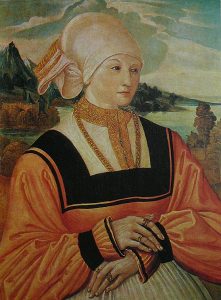
28th May, 1947: Eigruber is executed
19th April, 1947: the Financial Directive of Lower Austria issues a decision of restitution of the two boxes of manuscripts that were dispossed from Göttweig Abbey
3rd June, 1948: the impounding of the Krems Museum and Göttweig Abbey items is lifted on the condition that the items from Göttweig are promptly returned to the re-founded monastery
22st June, 1948: in Altaussee, Bad Aussee and Kremsmunster the new councilor in Krems for culture and education, Fritz Dworschak, receives the five boxes and three sculptures aretfacts from Krems Museum along with the two boxes of manuscripts Göttweig Abbey, with the receipt noting in pencil that the Krems Museum sculptures were in Bad Aussee
23rd June, 1948: in Seitenstätten, the Göttweig manuscripts are entrusted, as requested by Göttweig Abbey, to the monastery at Seitenstetten
24th June, 1948: Saint Vitus in a Vat and associated items return to Krems
26th June, 1948: in a letter Dworschak thanks the BDA for their help and cooperation and extends thanks to the vicar of the Parish Church at Bad Aussee who also played a part in looking after the Krems sculptures. He adds that that the vicar is concerned about the Luchsperger statues that are still in the Hospice Church and which for effective security, should be returned to the cathedral in Wienerneustadt as soon as possible
1st July, 1948: under the Nazi regime, Altaussee had been made a part of Upper Austria and so had fallen under Eigruber’s control and equally under American jurisdiction, when it was agreed that Upper Austria was to be an American occupied zone. Ten years after the Annexation of Austria, Altausse was transferred back to the region of Styria to which it had originally belonged, whilst remaining under American juridiction even though Styria was a British occupied zone
During the course of 1948, Pöchmüler’s account of events at Altaussee, Weltkunstschätze in Gefahr, is published by Pallas Verlag, in Salzburg. In a forward written by Eder, the vericity of Pöchmüller’s version of events is confirmed. As a result of this, the Ministry for Education requests from Michael an account explaining the discrepencies between his own claims and those of Pöchmüller. After playing for time, Michael eventually delivers a patchy and inconsistent report. In 1951 he is suspended and the next year is sent into early retirement. Although Pöchmüler continues to fight to have his role at Altaussee recognised, his attempts are repeatedly blocked. This is due to the links between the Michael and the leader of the Salzberg resistance group, Albrecht Gaiswinkler, who from 1945 to 1949 was a socialist politician and who in 1947, published a book in which he claimed for himself a hugely exaggerated and largely ficticious role in preventing the destruction of the mine and art at Altaussee. Although Gaiswinkler was expelled from the Austrian Socialist Party in 1949, rehabilitating Pöchmüller would emphasise the discredited Michael and by association, the disrepute of his associate Gaiswinkler, with this in turn reflecting unfavourably on the socialist party. Equally however, as time goes by, Pöchmüller’s demands for compensation become increasingly unreasonable making it easier to ignore the facts of the injustices that he was made to suffer.
On 14th June, 1985 at Altaussee, a specially commissioned relief of Saint Barbara, the patron saint of miners, was unveiled outside the main entrance to the mine, as a part celebrations commemorating the 40th anniversary of the saving of the mine and the priceless collection of art that it once housed. Made according to a design by Irmgard Schlömmer, the sculpture was executed by the Rousek Stonemasony in Rottenmann and shows the Saint protecting threatened and endangered cultural property.
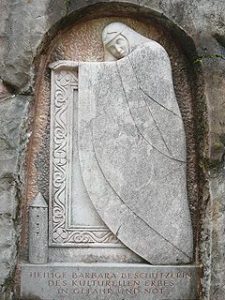
The dedication reads: „Dedicated to the memory of the cultural property that was deposited and saved in the salt mine at Altaussee during the Second World War“, with the monument being set up at the initiation and expense of the Austrian Salt Working Company in Altaussee. Still working, the saltmine at Altaussee can today be visited and deep inside the mountain, there is an exhibition that includes a plaster cast of Michangelo’s Brugges Madonna. In July and August there are tours with a specific focus on the mine’s dramatic role in art history. See: www.salzwelten.at.
Sources:
Anonymous, Verzeichnis der im Schloss Baumgarten eingelagerten Gegenstände des Archivs und Museums der Stadt Krems, 1943, Stadt Archiv Krems
Diverse authors, original documents from 1943-1948, BDA Archives, Departement for Provenance Research, Restitutionsmaterialen Kartons 22/1, 22/2, 22/3 (Bergungsort Altaussee), Restitutionsmaterialen Karton 19 (Klöster: Stift Göttweig)
Maximillian Eder, Die Kunstgutbergsaktion Salzbergwerk, Altaussee – kurzer Bericht über deren Anfänge und Verlauf bis Eintreffen der US-Truppen, am 8. Mai, 1945, eye-witness report held by the Dokumentationsarkiv des österreichischen Widerstandes (DÖW)
Albrecht Gaiswinkler, Sprung in die Freiheit, Riedl Verlag, Vienna/Salzburg, 1947
Emmerich Pöchmüller, Weltkunstschätze in Gefahr, Pallas Verlag, Salzburg, 1948
Irmgard Schlömmer, Steinmetz Rousek and others, Dokumente zur Brunnenanlage, Archiv der Saltzwelten AG, Hallstatt
Christian Reder, Zeitgeschichte – ein Beitrag zum Abbau von tauben Gestein: im Salzbergwerk, in Ausseer Beiträge zur Zeit- und Kulturgeschichte, Steirisches Institut für Zeitgeschichte Bad Aussee, Bad Aussee, 1985
Lynn Nicholas, The Rape of Europa, Vintage Books, New York, 1995. A highly readable but nevertheless scholarly reference book that details the art-looting and dispossession programms run by the Nazis and tells the story of the setting up of the MFAA and its activities in Europe
Eva Frodl-Kraft, Gefährdetes Erbe: Österreichs Denkmalschutz und Denkmal Pflege 1018-1945 im Prisma der Zeitgeschichte, Volume 16. Included is: Theodor Brückler, Gefährdung und Rettung der Kunstschätze: Versuch einer kritischen Rekonstruktion. Studien zu Denkmalschutz und Denkmalpflege, Böhlau, Vienna, 1997
Robert Edsel, Monuments Men, Center Street, New York, 2009. This work of faction, based on and inspired by The Rape of Europa, tells the interwoven stories of a number of MFAA people, with a series of sensational discoveries leading towards a culmination at Altaussee
Konrad Kramar, Mission Michangelo, Residenz Verlag, Vienna, 2013. This reference book written for a general readership begins with the Nazi art-looting and dispossession programms and examines the Austria reports, memoirs and eye-witness accounts of events at Altaussee during the last weeks of the war
Monuments Men, a Hollywood film derived from the book of the same name with a star-studded cast and direction by George Clooney, Columbia Pictures and Babelsberg Film Studio, Hollywood/Potsdam-Babelsberg, 2014
Die moderne Niebelungen salzen ihre Schätze ein .., Anneliese Schallmeiner, in Bergung von Kulturgut in Nationalsozialismus, Mythen – Hintergründe – Auswirkungen, Pia Schölnberger and Sabine Loitfellner (Ed.), Kommission für Provenenzforschung, Böhlau Verlag, Vienna, 2016
Ein Dorf wehrt sich: das Geheimnis von Altaussee, directed by Gabriele Zerhau, Mona Film/Hager Moss Film, 2019. This Austria/German film was produced for television and tells the Altaussee story from the point of view of local protagonists
Bernhard Rameder, Göttweiger Bücher in Salzbergwerk. Die Bergung der Göttweiger Handschriftensammlung während des Zweiten Weltkriegs in Salzbergwerk Altaussee in Von Schreiben und Sammeln, Einblicke in die Göttweiger Biblioteks Geschichte, Astrid Breith (Ed.), Studien und Forschungen aus dem Niederösterreichischen Institut für Landeskunde Volume 74, Verlag NÖ Institut für Landkunde, St. Pölten, 2021
Salzwelten GmbH., Via Salis, ein kultur- und industriegeschichtlice Rundweg durch Altaussee, Salzwelten GmbH., Salzbergerstraße 21, Hallstatt, 2022
At Reloading Humanism, the message of the saint from Krems and the 13,14,15 triangle is that if we are to have a future, we must re-establish a balance within ourselves in which the rational, the emotional and the intuitive are combined in ways that allow them to compliment each other. Only so can we, living in tune with ourselves, live in tune with nature and pull off the miracle that is needed if we are to solve the diverse crises that we ourselves have brought into being.
